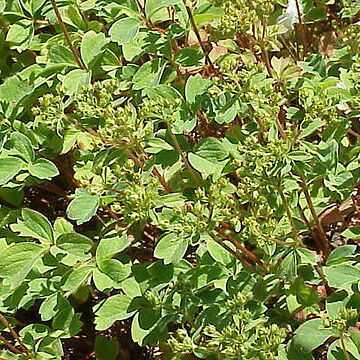Herbs, perennial, [0.1–]0.2–1.5(–2)[–3] dm, [subglabrous or] sparsely strigose to subappressed pilose [to densely tomentose or sericeous]; horizontal rootstocks branched, compact, woody. Stems 1–10+, prostrate to ascending [or erect], ?green to reddish?. Leaves deciduous or marcescent, mostly basal, alternate, ternate [or simple]; stipules persistent, basally adnate to petiole, sheathing, lanceolate to ovate, margins entire; petiole present; blade bluntly ovate to obovate [or cordate] in outline, 1–3[–4] cm, foliaceous, leaflets 3, cuneate or oblanceolate to broadly elliptic or obovate to nearly orbiculate, margins flat, shallowly (2–)3(–5)[–7]-toothed apically, ?central tooth usually shorter than others?, venation pinnate, surfaces often more densely strigose on veins and margins, sometimes glabrous. Inflorescences terminal, (1–)3–12-flowered, loosely capitate or corymbose (or flowers solitary); bracts present, reduced; bracteoles absent. Pedicels present, ?straight or curved?. Flowers 4–7[–10] mm diam.; epicalyx bractlets 5; hypanthium shallowly cupulate, 0.5–2 × 2–4[–5] mm, usually strigose, sometimes glabrous; sepals 5, spreading, broadly lanceolate to ovate; petals 5, ± yellow, oblanceolate [to obovate], ?shorter [to slightly longer] than sepals?; stamens 5[rarely 10], shorter than petals, ?filaments columnar, glabrous, anthers with theca solitary, ± horseshoe-shaped, rimming an indistinct connective, dehiscing by continuous marginal slit?; torus hemispheric; carpels 5–15[–30], glabrous, styles lateral, ?narrowly clavate?; ovule 1. Fruits aggregated achenes, individually deciduous, 5–15[–30], obliquely ovoid, 1.2–1.7 mm, glabrous; hypanthium persistent; sepals persistent, erect; styles tardily deciduous, ?jointed?. x = 7.
More
Herbs perennial, often woody based. Flowering stems prostrate to erect. Leaves pinnate or palmately 3–5-foliolate; leaflets serrate at apex or margin, rarely entire. Inflorescence a cyme or solitary flower. Flowers usually bisexual, rarely unisexual. Hypanthium saucer-shaped or cupular. Sepals (4 or)5, alternate, persistent; epicalyx segments (4 or)5. Petals (4 or)5, yellow, purple-red, or white. Disk usually markedly broad, rarely not so. Stamens (4 or)5(–10); anthers 2-loculed. Carpels 4–20, free; ovule usually ascending; style sub-basal, lateral, or subterminal. Achenes few, inserted on elevated, dry receptacle. x = 7.
Hypanthium saucer-shaped; sep 5, oblong, acute, reticulately veined, alternating with linear-oblong bractlets; pet 5, yellow, minute, spatulate; stamens 5; pistils 5–10, rarely more; ovule 1, ascending; style filiform, lateral; fr a small, smooth achene; perennial herbs with long-petioled, 3-foliolate lvs and small fls in cymes. 6–7, all but ours Asiatic.

